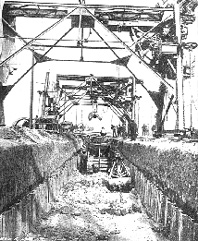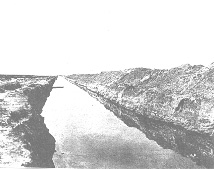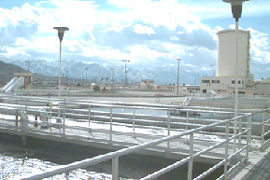Conduits of Civilization
September 28, 1998
According to the American Public Works Association ("Public Works") in its book entitled, History of Public Works in the United States 1776-1996, "America's sewage systems have been rightly proclaimed as the Conduits of Civilization." This description denotes the contribution that sewer systems have made to the nation's sanitation, public health and quality of life.
Sewage deposal in the United States, until the late 1800s, was accomplished with privy vaults, backhouses and cesspools, and was considered a private responsibility. The first sanitary sewer design was in 1880 by George Warning, Jr. at Memphis, Tennessee and Benezette Williams at Pullman, Illinois. Subsequently, the fundamentals of sewer design and construction developed during the early twentieth century. With the construction of sewer systems, local government acquired the responsibility to finance, construct and operate and maintain the systems. The public health benefits of sewers and later the treatment of sewage are immeasurable. Sickness and death were a common result of poor or no sanitation and disposal of human waste. Outbreaks of cholera and other epidemics scourged American cities during the nineteenth century. For example, according to the Public Works publication, "…cholera and typhoid killed more soldiers in the Civil War than did hostile action."
|
By 1903 the sewer system had expanded from the central business district outward with 240,599 feet (45.57 miles) of pipe installed. In that same year, the City Engineer recommended an intercepting sewer be constructed in the western part of the city, and a pumping plant located at Ninth North for pumping sewage to the Gravity Outlet Sewer that had been completed earlier in 1897. The Gravity Outlet Sewer began at Fourth East and Ninth South passing the southwest corner of the City and County Building and thence west and north to the Sewage Farm located on property that today is at about Redwood Road and I-215. In 1908 the Gravity Outlet Sewer was flowing 21-second feet.
In 1908, the Intercepting Sewer Pumping Station located at the southeast corner of the intersection of Eighth West and Seventh North was operating at a capacity of 4,500 gallons per minute.
The five-mile Outlet Canal from the Gravity Sewer to the Great Salt Lake was completed on November 10, 1911. On this date the sewage of the City was turned into the canal, and by written agreement with the New State Gun Club, a perpetual outlet was secured in order to discontinue the flow of sewage into the Jordan River. Thus the City transported its sewage to the salty Great Salt Lake where it was rendered harmless, and in a way, for the first time, treated the sewage through this natural process.
A special sewer district was created in 1911 for the southeast section of the City, including all streets not already provided with sewer mains from Fifth South to Ninth South and from Ninth East to Fort Douglas.
Again according to the Public Works, "Broad irrigation or sewage farming was first used in 1872. Due to the large tracts of land required and the insect and odor problems sewage farming was not widely used in the East; however, it was practiced in the arid West." Because of the fertilizer value of the sewage, crops were grown on the irrigated fields. Salt Lake City leased its sewage from the Sewage Farm for irrigation purposes from 1905 to 1912 according to Salt Lake City Engineer's Reports. This could have occurred for a longer period, but the documentation was not readily available.
|
The current Oil Drain - Sewage Canal to the Great Salt Lake was completed in 1924. Dug to drain the low lands around the Jordan River, it would also provide a means of conveying the gravity sewer.
Population growth and increasing pollution required a national program to abate the growing quality deterioration of the nation's water. The first milestone in federal water quality legislation was in 1899 with the Rivers and Harbors Act, which prohibited discharges of refuse into waterways that would interfere with navigation without a permit from the U.S. Army Corps of Engineers. It would take nearly one-half century before Congress passed the 1948 Water Pollution Control Act. This act provided limited federal financial assistance for municipal wastewater treatment facilities. In 1965, the Water Quality Act required states to develop state water quality standards for interstate waters, and created the Federal Water Pollution Control Administration to establish broad guidelines and approve state standards. The Environmental Protection Agency was formed in 1970 to administer the nation's environmental programs. The 1972 Clean Water Act established national uniform technology-based effluent standards for industrial discharges and a permit system for all point source discharges. As a result, today nearly two-thirds of the nation's waters are swimmable and fishable, compared to only one-third in 1972.
In 1952 the Utah Water Pollution Control Act was pass by the State Legislature.
On September 30, 1963 a groundbreaking ceremony was held for Salt Lake City's new Sewage Treatment Plant. Supported by the League of Women Voters, Chamber of Commerce, Kiwanis, Rotary and other service clubs and health authorities, and approved by the City's taxpayers, the City initiated a $19 million Capital Improvements Program, that included $7 million for a new sewage treatment facility. In the announcement it was stated, "Upon completion some 460 working days hence, the plant will enable the City to abandon its present primitive and - to many- offensive system of discharging some 32 million gallons per day of raw sewage daily via a nine-mile open canal into the Great Salt Lake."
|
In 1979, the sewer collection and reclamation division was transferred to the Department of Public Utilities and made an enterprise funded utility. The treatment plant was upgraded and new unit processes added to improve treatment efficiencies as part of a 201 Facilities Plan adopted by the City Council on December 7, 1982. This 20-year plan will end in the year 2002.
During the next several years, the Department of Public Utilities will develop a new plan to ensure that Salt Lake City continues to meet its environmental obligations and to provide "Conduits of Civilization" into the future.


